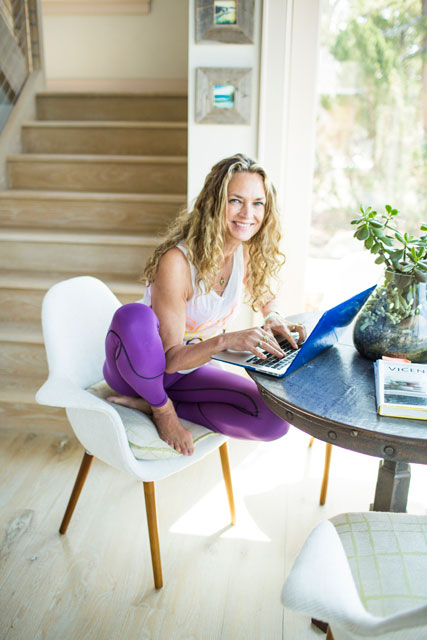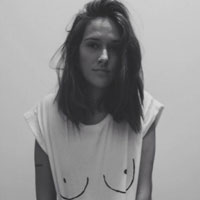Have you ever heard of the “First Lady of Yoga?”
I have to admit, I haven’t. That is, until I got an opportunity to interview Colleen Saidman Yee.
Colleen is a transformed rebel, model, now a yoga teacher and an author, and the more I read about her, the more I am convinced her “title” is completely justified. But don’t take my word for it, read the interview below and see for yourself.
I’d like to start at the beginning: How did you find yoga? Or how did yoga find you?
I was in my mid-20s and was super busy with my fashion career. At the time, I was into intense exercise: running, boxing and whatever aerobic boot-camp classes I could fit into my schedule. My friend and next-door-neighbor Kathy Law (now Kathy Freston) was into yoga and kept pestering me to try it. I considered myself an athlete, so I pooh-poohed her, but eventually I agreed (and assumed I would go get my real workout after class). I followed along as best I could, but there was a lot I couldn’t do, which surprised me. I considered myself in great shape but I didn’t have balance or flexibility.
That evening, I walked out onto Broadway, a street I’d walked down hundreds of times before, but it was different. The lights, the colors and the smells of the city seemed crystal clear. My senses were truly alive, maybe for the first time in my life. It was an awakening of sorts. The yoga door had opened, even if it would be a while before I walked through it wholeheartedly.
You were a rebel, then a fashion model and now you’re the “First Lady of Yoga.” How did this transition happen?
Well, it was actually quite a few transitions. I definitely was a rebel as a teenager and got seriously into drugs with my boyfriend, who became my first husband. I ran away from Indiana when my father insisted I go into rehab. I came to my senses in a rundown hotel in New York and kicked heroin, cold turkey.
I got a job working as a coat-check girl at a restaurant on Madison Avenue, and was basically discovered by the modeling agent, Zoli. He walked into the restaurant, looked me up and down, handed me his business card, and said, “I think you could be a model. Call me.”
Even though I had dreamed of being a model in New York City, I never imagined it could be a reality. I worked my ass off, though, and I became successful as an international model. But as much as I loved it, the focus of modeling is all about the external. The rejection you experience on a daily basis strictly because of your looks is depleting and defeating.
When I finally turned to yoga seriously, it hooked me. It was visually beautiful. It provided the devotion of prayer, the endorphins of running and the altered state of drugs, as well as a community of people who felt similar moral responsibilities to the world. Yoga pointed me in the direction of insight without the harm of drugs.
I think I had always been searching for that ineffable thing, beyond what you can touch, taste, hear, feel and smell. I have always known that there is a magic that we can connect to. I tried many other paths to get there in my life. But I found that yoga is the most direct route. Yoga filled the void on so many levels.
Tell us more about your book Yoga For Life? Where did an idea for it come from? Has writing always been a passion or was it a logical next step in your career?
The truth is that there was no logic or planning involved. I had never even considered writing a book. I was a druggie and a college dropout from Bluffton, Indiana. Unlike me, my six siblings all have master’s degrees and Ph.Ds. I’ve always thought of them as the voices and writers in my family. I was a fashion model and models are basically mute.
That all changed when I discovered yoga and became a yoga teacher. Along with my passion, I began to find my voice. The New York Times published that article about me; to this day, I don’t know why they decided that I was worth an article.
But after it came out, one of my longtime students, who is also a renowned literary agent named Esther Newberg, said to me, “Why don’t you write a book?” She’s a powerful woman whom you just don’t say no to. She’s also a dear friend whom I trust. So I dove in, not knowing what I was getting into. What I knew on some level was that I had more potential than I thought and that I had a voice that had been buried.
I have to say, I love your book cover! You perfectly manifest the First Lady/rebel/yogi with the dress/Converse/yoga pose.
Thank you.
What inspires your yoga practice, and how has your yoga practice developed though the years?
The inspiration for my yoga practice changes on a day-to-day basis. I won’t kid you—like everybody, there are some days where my inspiration is lacking. Usually my inspiration comes from something I happen to read in the newspaper or from a poem, a song or a yoga book that I pull off the shelf. It can also be a class that I take or a conversation that I have with a stranger.
I always practice in the morning before I teach. I work out the sequence on my mat so the asana class is in my body when I teach it. Then it feels like my body is talking to my students, and it seems more authentic.
Rodney has inspired me and my practice enormously. He is an engineer of the body, and he’s taught me a lot about the mechanics and architecture of the body. Over the years, he’s influenced me to change the alignment principles and the sequences that I teach.
On June 21st you will be leading Solstice, the big NYC yoga class in Times Square and Urban Zen is one of the charities supporting it. Urban Zen is a charity that you’re a part of with Donna Karan. Tell us more about that. What are your goals, what are you working on?
Our dear friend Donna Karan, with whom we developed Urban Zen Integrative Therapy, loves to say, “There is no healthcare without self-care—there is only sick care.” Our goal is to have an Urban Zen Integrative therapist at every bedside in hospitals and to have all caregivers using the modalities for self-care. The UZIT program is in many hospitals around the country. We use in-bed yoga movements, meditation, breath awareness, restorative poses, essential oils, and Reiki as the main modalities to bring the humanness back to healthcare.
Part of Urban Zen is clothing. As most people are aware, fashion can be a dirty business, with production taking place in third world countries, and people working for almost nothing. Ninty-seven percent of all cotton grown in India is Monsanto-owned GMO cotton. How is Urban Zen different?
I’m the co-director of the Health and Wellness program of Urban Zen. I don’t have anything to do with the clothing line except that I love to wear it. Donna is the most talented, generous and compassionate woman I know. I’ll ask her this question and let you know.
It seems like you’ve pretty much done it all: yoga-teacher trainings, DVDs, Gaiam yoga studio, massive festivals, a book. What’s next? I see you have a retreat planned in Italy. Will you be leading any workshops in Europe? We’d love to come and practice with you on this side of the world as well.
It’s true. Rodney and I have done a lot in the yoga world. We’re doing everything you mentioned, including a new extensive beginner’s track for Gaiam TV, which we’re really excited about. We’ll be teaching an event in Central Park on September 2nd where they’re expecting 10,000 participants. We taught in Paris and London last year and we’re planning another workshop in London for 2016. We teach almost every year in Marrakesh, which is just a hop, skip and jump away. Stay posted.
Thank you for your time! I wish you all the best with your book and upcoming events. Looking forward to reading the book!
Thank you so much. I love Elephant Journal and was hoping to do an interview with you. Peace.
~
Author: Katarina Tavčar
Editor: Katarina Tavčar
Photo: Used with permission.












Read 4 comments and reply